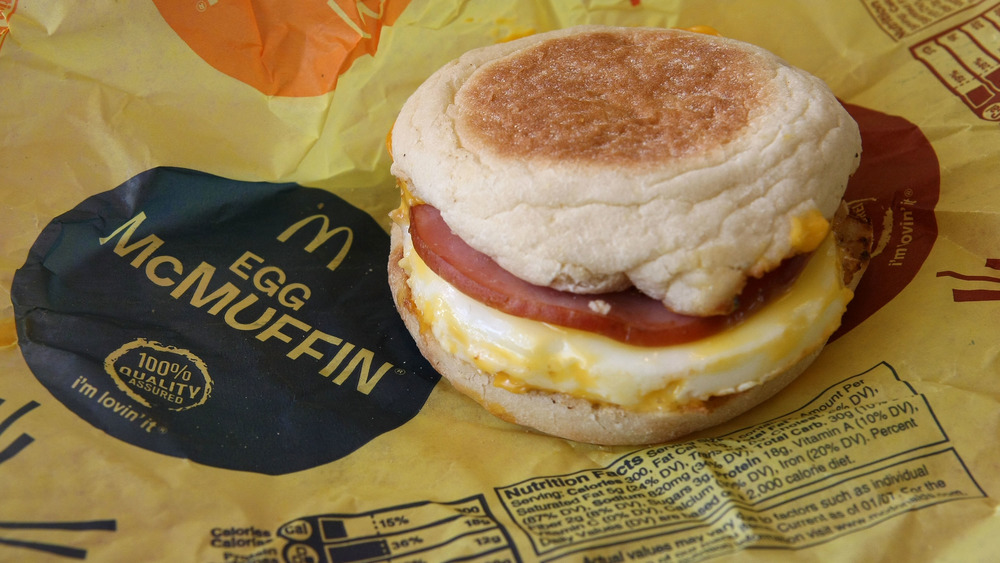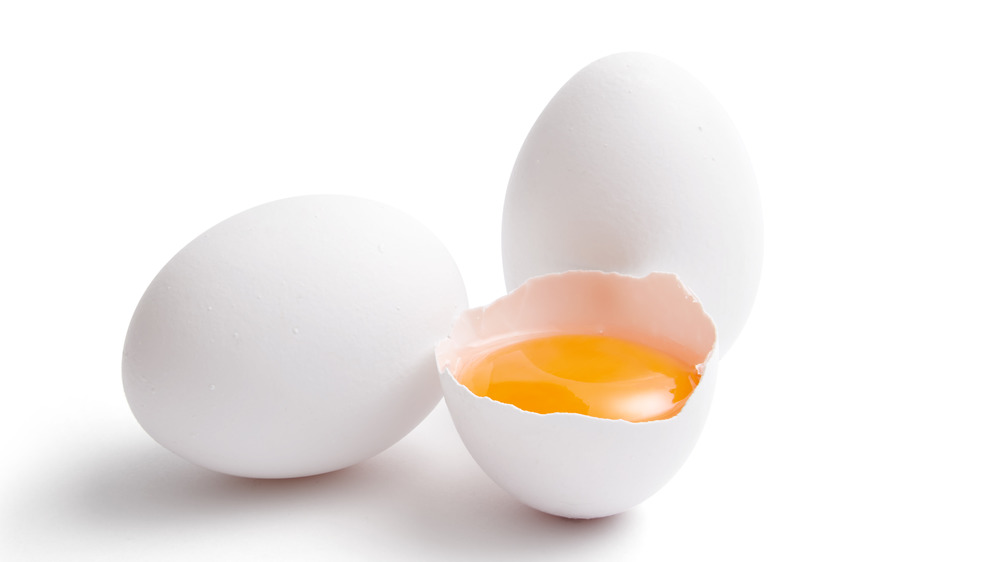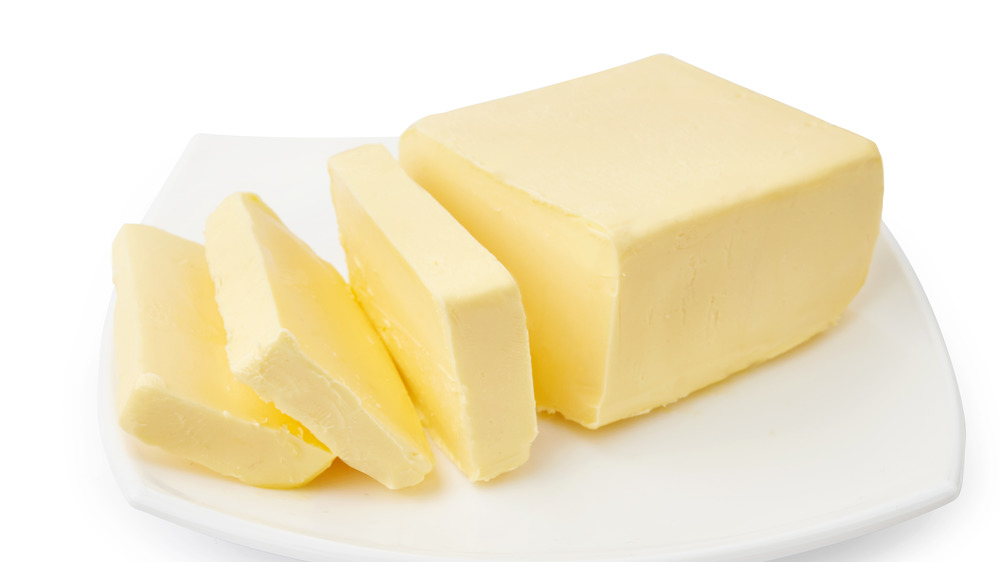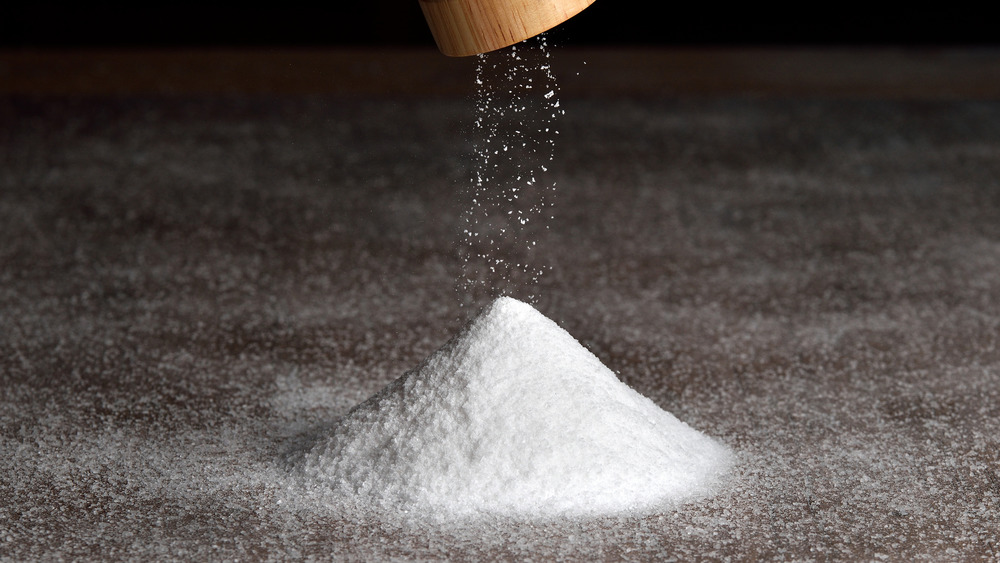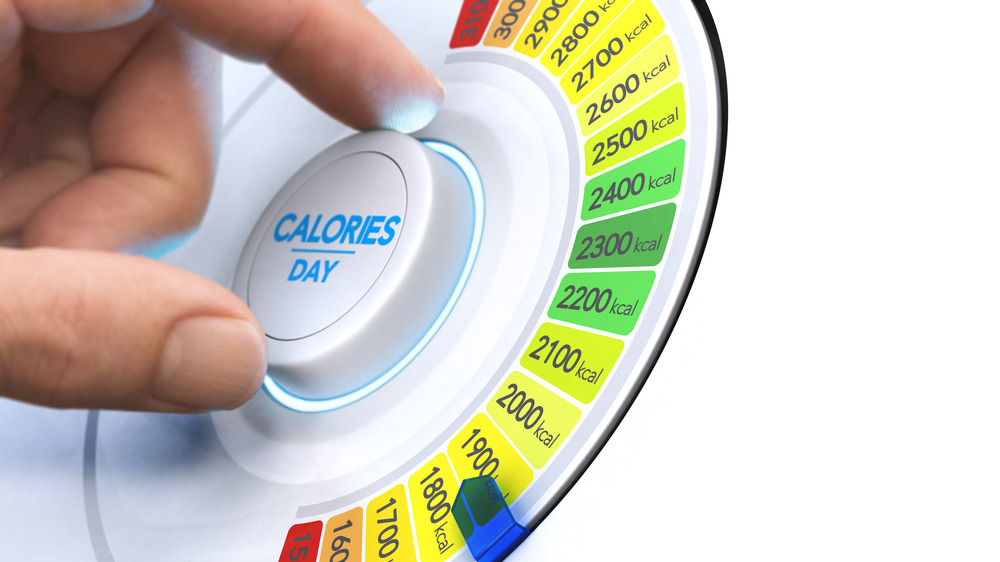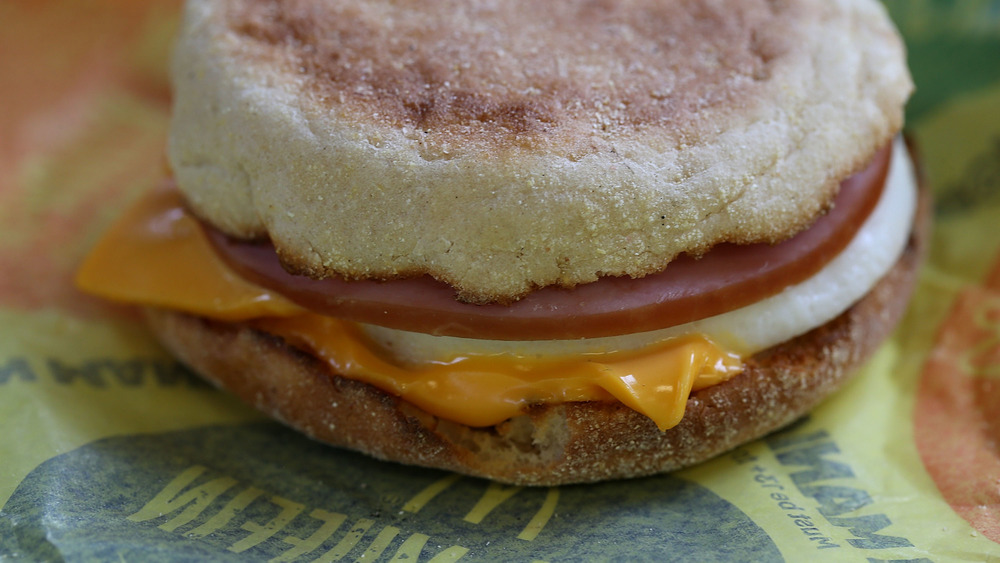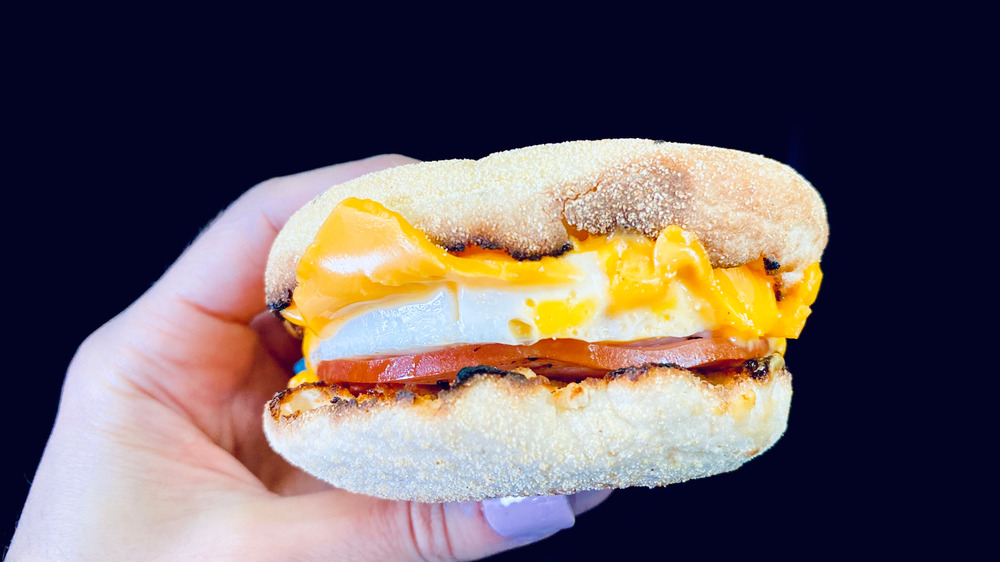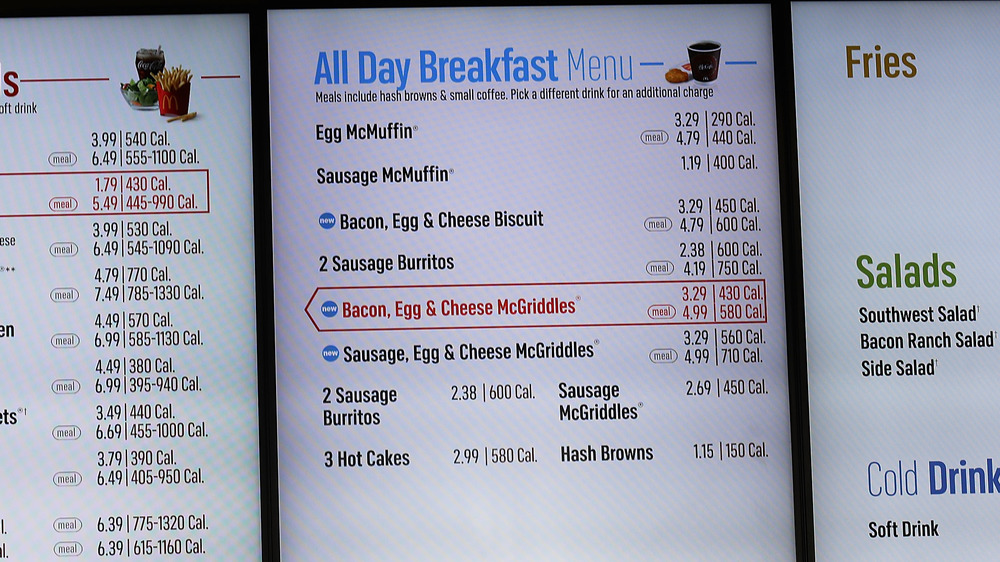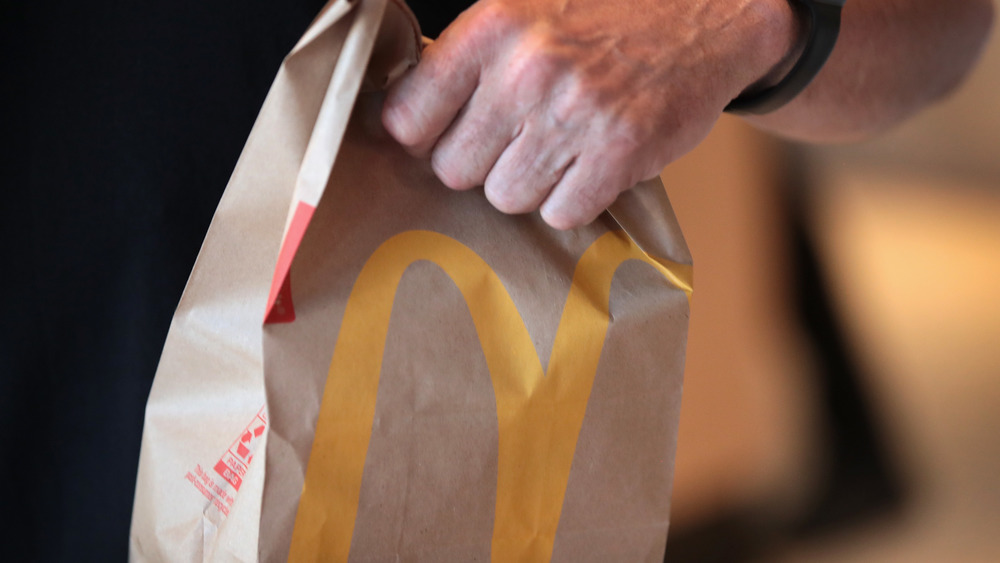This Is Why McDonald's Breakfast Sandwiches Are So Delicious
It's hard to beat a McDonald's breakfast. The fast food giant's breakfasts are so beloved that, after years of the public begging, many items from the breakfast menu were offered at all hours of the day, though sadly for now that has been curtailed due to changes brought on by the COVID-19. When it comes to that McD's breakfast, the sandwiches are the stars. Whether you choose a simple Sausage McMuffin, a loaded Sausage, Egg & Cheese McGriddle, or anything in between, it's hard to go wrong, especially when you add a hash brown, juice, and McDonald's surprisingly good coffee.
But why, exactly, are the breakfast sandwiches from McDonald's so good? What is it that makes them so satisfying, filling, and rather addictive as well?
For one thing, salt. And butter. And fat. For while delicious they may be, McDonald's breakfast sandwiches are far from healthy. But they do make a wonderful breakfast treat now and then, and as you can always count on a McDonald's breakfast sandwich to taste the same no matter where you get it, they are staples of the traveler, especially the road tripper looking for calories that will help keep them cruising.
Beyond the calories and saturated fat and all is the genuine flavor that comes thanks to years of experimentation and development by a team of professional chefs with an impressive pedigree, including top graduates from the Culinary Institute of America and a team of dietitians. Here's why the sandwiches are great.
The eggs on two McDonald's breakfast sandwiches are cooked fresh, not heated up from frozen as many people suspect
Contrary to popular misconception, many beloved breakfast sandwiches served at McDonald's are not made using pre-cooked and reheated eggs, but are indeed prepared with fresh eggs. The two McMuffin sandwiches (the classic Egg McMuffin and the Sausage McMuffin with Egg, e.g.) are used with eggs that are cracked immediately prior to cooking, so they hit your mouth hot off the griddle, not warm out of the microwave.
That said, most McD's sandwiches with eggs do not see their staple protein prepared quite so freshly. All of the biscuit, bagel, and McGriddle sandwiches are, according to the company's own site, made using "liquid eggs that are pre-cooked and folded before being flash frozen by our suppliers." They are reheated before being plopped onto your sandwich, and while they taste fine, there is a definite lack of that freshness that makes the McMuffin sandwiches so tasty.
McDonald's breakfast sandwiches are packed with fat
In case you needed a confirmation that McDonald's breakfasts should be a treat, not a staple, you just need to look at the numbers. Specifically, the amount of fat grams in each breakfast sandwich and the percentage of the daily recommended maximum fat so constituted. According to the Cleveland Clinic: "The dietary reference intake (DRI) for fat in adults is 20% to 35% of total calories from fat. That is about 44 grams to 77 grams of fat per day if you eat 2,000 calories a day."
If we start with the Egg McMuffin, the old standard-bearer, the fat issue isn't all that bleak. The sandwich has about 12 grams of fat on average, almost half of which is saturated fat. So that's nearly a third of your DRI on the lower end of the scale, but not a major problem. Then we jump to the Sausage McMuffin with Egg, which has nearly double that at 22 grams of fat, well over half the lower end of the total fat range. The Sausage, Egg, and Cheese McGriddle? That's 32 grams of fat in your hand — half the recommended total.
Considering those fat numbers, it's probably best to skip the hash brown, if you have the willpower. It packs eight grams of fat into its 150 calories.
Eggs for McDonald's breakfast sandwiches are cooked with lots of butter
Butter, on its own, is pretty gross. But slathered on toast, drizzled on pancakes, or of course used in cooking, is pretty much delicious perfection. Our bodies crave the fat and saltiness of butter for reasons of evolutionary survival, while our tongues crave butter because it accentuates the flavors of any other foods it graces. And McDonald's breakfast sandwiches are graced with a lot of butter. McDonald's website reports that its "scrambled eggs are made with liquid eggs that are cooked fresh on our grill with real butter," and the folded eggs that you might find on a biscuit sandwich are also "prepared on the grill with real butter." Basically, if it's not a fresh-cracked egg or egg white, butter is involved.
Also, salted butter is listed as an ingredient in every sandwich on the McDonald's breakfast menu except for the McGriddles, but those have maple crystals cooked right into the pancake-style "buns," so don't worry, there's still bountiful flavor afoot.
McDonald's breakfast sandwiches are loaded with salt
Our bodies need salt for everything from proper function of muscles to balanced fluid retention to headache prevention and so much more. And over the course of human history, the relative difficulty of finding this necessary substance led us to develop a keen taste for it — sometimes even a craving. McDonald's breakfast sandwiches more than satisfy that craving, because they are jam-packed with salt. Take the Bacon, Egg, and Cheese McGriddle: it has a whopping 1,230 milligrams of sodium, which represents 54 percent of the allotted daily value for someone on a 2,000 calorie diet. And that's in just 430 calories, meaning to stay balanced, you'd need to get the remaining 46 percent of your daily sodium from 1,570 calories, and that's no easy feat.
Even that ostensibly simple Hot 'n Spicy McChicken Biscuit, which is just a spiced chicken patty on a buttered biscuit, is a veritable salt mine, with 1,130 MGs of the stuff representing 49 percent of your DRI. The good ol' Egg McMuffin? That's a better bet, with "just" 770 milligrams of salt that account for 33 percent of your daily dose.
Many McDonald's breakfast sandwiches hit the perfect calorie sweet spot
There are two feelings that are all too common following a meal that at once have something in common, yet are also complete opposites: These are the feelings of having eaten to the point of being uncomfortably full, and the feeling of having eaten too little and yearning for more. The common factor? Both leave you unsatisfied. With most McDonald's sandwiches, however, you hit that expert-recommended sweet spot for per breakfast meal calorie intake of between 350 and 500 calories.
Let's average those numbers and call 425 calories for breakfast the sweet spot, then look at a few McDonald's breakfast sandwiches. The Sausage McMuffin is close, with 400 calories. So is the Bacon, Egg, and Cheese Biscuit, with 460 calories. Then you have the Bacon, Egg, and Cheese McGriddle, which almost nails it at 430 calories. Many of the sandwiches are perfect for leaving you sated but not stuffed.
McDonald's uses the brilliant egg ring for perfect egg patties on some breakfast sandwiches
Ever wonder how the egg patty on the Egg McMuffin and the Sausage McMuffin with Egg comes out in such a uniformly perfect disc every time? The answer is the egg ring, a brilliant device that sees eggs freshly cracked into a ring, their yolks then broken, and then a lid lowered down and a bit of water sprayed over the top. The effect, therefore, is much like a poached egg, yet one that can be cooked fast on a griddle (and without the maddening care needed to properly poach an egg, for that matter).
McDonald's egg patties are prepared fresh in large batches thanks to the egg ring, and can then be stored warm for a while without losing that fresh taste and satisfying texture. The egg ring is why so many McD's breakfast sandwiches are great, and it is also why you probably can't ever quite replicate them at home.
There are four different types of bread used in McDonald's breakfast sandwiches
The basic breakfast sandwich doesn't seem to have much variety, really. It's usually a meat, a cheese, and an egg housed between bread, with the only difference being what meats are used, and in some cases how the eggs are prepared. But the McDonald's breakfast menu also gives you quite a bit of choice when it comes to the bread. You can enjoy your meat, egg, and cheese combo between any of four different types of bread: there's the biscuit, the English muffin, the McGriddle (basically a pair of handheld pancakes, for the record), and the bagel.
And if you ask nicely, you can probably go off-menu and get an egg sandwich on the same bun used for burgers, so in fact, you can argue that there are really five bread options for breakfast sandwiches at McDonald's. (Also, try using a pair of hash browns to go next level on taste.)
McDonald's offers nearly a dozen different breakfast sandwich options
Sure, it's Burger King that offers you the chance to "Have it Your Way," but McDonald's lets you have a huge selection of different breakfast sandwiches. There are many different sandwich options on the McDonald's breakfast menu, and that's not even to mention their other offerings, like Fruit and Maple Oatmeal, the sausage burrito, large breakfast combos, and the new breakfast pastries (which you may be able to get for free).
If you often dine at McDonald's in the morning, you'll be glad to have all the variety of options. So too, will this be appreciated if you're trying to feed a group of people that contains its share of picky eaters (also known as children). Breakfast has been on the menu, so to speak, since 1972, the year McDonald's first offered the Egg McMuffin, though it was only rolled out to select markets at first as they tested their new initiative. Spoiler alert: McDonald's breakfasts passed the test.
McDonald's adds new breakfast sandwiches (and retires unpopular ones)
There are certain foods you can always count on when you go to a McDonald's, like the Big Mac and the Egg McMuffin. And the fries. But you can also count new menu items appearing from time to time, like the new blueberry muffins the chain is now selling. Equally important to adding new items to the menu, though, is culling those foods that just don't work, like for example an Eggs Benedict McMuffin.
Do you remember the Eggs Benedict McMuffin? The chain is probably pretty happy if the answer is no. It came out in 2016 then fizzled fast, and to their credit was pulled from the menu. You can't blame them for trying, and you can support them from admitting a mistake and moving on. Then you have the McGriddle, which came out in 2003 and became a menu stalwart.
McDonald's has had a relationship with the same bakery for more than 55 years
Part of the thing customers love about McDonald's (and all chain restaurants, of course) is the consistency of the flavors. Whether you go to a McD's in Tallahassee or Toledo or Tucson, you know what to expect when you order an Egg McMuffin. Or a Quarter Pounder with Cheese. Or a Filet-O-Fish. And so on. One of the ways McDonald's restaurants in America achieve such reliable uniformity of taste is by sourcing bread from the same bakery, namely Fresh Start Bakeries in Brea, California, a city not far from where the chain was founded back in the 1940s. (It should be noted that restaurants in some states get their bread from another bakery).
McD's has sourced bread for its United States locations from Fresh Start Bakeries since 1964, so after more than 55 years working together, it's of little surprise that they have things down on the consistency side of things. Oh, and you'll get that same bread at many McDonald's locations overseas, too. The bakery has 27 operations around the globe, and for a sense of the scale of the operation, they also supply bread to Costco.
